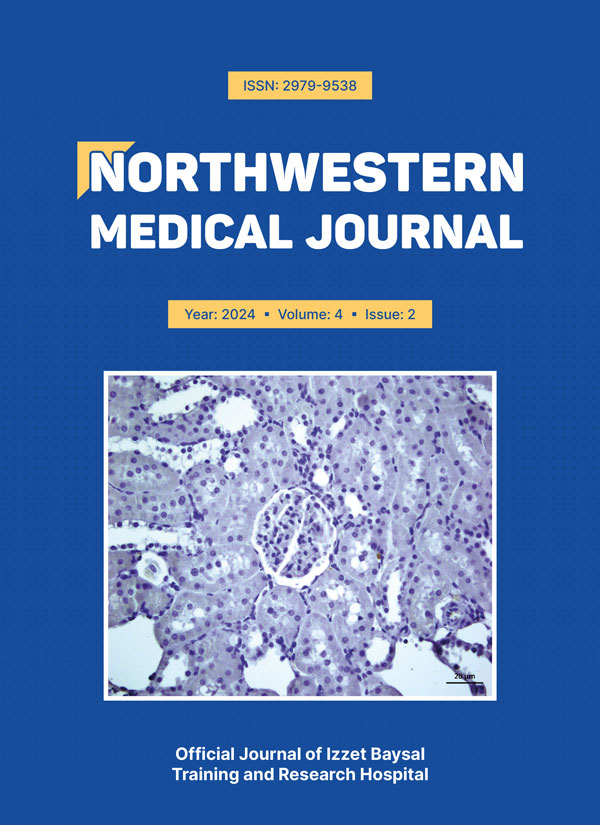Abstract
Aim: Acute kidney injury (AKI) is a clinical syndrome that can cause disturbances in fluid-electrolyte and acid-base balance, resulting in the accumulation of nitrogen and uremic toxins along with the loss of kidney functions within hours or days. In this study, it was aimed to retrospectively examine patients with acute kidney injury to determine whether there is a relationship between infection parameters and urine volume.
Materials and Methods: The study included a total of 144 patients with (n=74) and without infection (n=70) out of 294 patients with AKI who received treatment between 1 January 2020 and 31 December 2021 in the nephrology clinic of a tertiary university hospital.
Results: The mean age was 66.4±15.7 (range:19-95) in patients with infection and 63.8±15.2 (range:36- 93) in non-infected patients. 51.4% (n=38) of those with infection and 52.9% (n=37) of those without infection were women. There was no difference between the individuals with and without infection in terms of age and gender (p>0.05). Infection was present in 51.4% (n=74) of the patients included in the study. Urinary tract (31.3%) and respiratory tract infections (13.2%) were the most common in those with infection. A moderate negative correlation was observed between admission CRP and discharge creatinine level in patients with infection. There was no correlation between PCT and sedimentation rate, urine volume and admission/discharge creatinine level. Moderate positive correlations were found between admission/discharge PCT and admission/discharge urine volume in patients without infection. In addition, moderate negative correlations were found between admission/discharge sedimentation rate and admission urine volume.
Conclusions: No correlation was found between PCT and sediment (incoming/exit) and outflow urine volume in patients with infection.
Keywords: acute kidney injury, CRP, PCT, Sedim, urine volume
Copyright and license
Copyright © 2024 The Author(s). This is an open-access article published by Bolu İzzet Baysal Training and Research Hospital under the terms of the Creative Commons Attribution License (CC BY) which permits unrestricted use, distribution, and reproduction in any medium or format, provided the original work is properly cited.
How to cite
References
- Göçken A, Ayar Y, Yavuz M, Yabacı A. Retrospective Evaluation of the Factors Affecting Etiology and Prognosis of Adult Acute Kidney Injury. Med Bull Haseki. 2020; 58: 216–22. https://doi.org/10.4274/haseki.galenos.2020.4790
- Park WY, Hwang EA, Jang MH, Park SB, Kim HC. The risk factors and outcome of acute kidney injury in the intensive care units. Korean J Intern Med. 2010; 25(2): 181-7. https://doi.org/10.3904/kjim.2010.25.2.181
- Lameire NH, Bagga A, Cruz D, et al. Acute kidney injury: an increasing global concern. Lancet. 2013; 382(9887): 170-9. https://doi.org/10.1016/S0140-6736(13)60647-9
- Liaño F, Pascual J. Epidemiology of acute renal failure: a prospective, multicenter, community-based study. Madrid Acute Renal Failure Study Group. Kidney Int. 1996; 50(3): 811-8. https://doi.org/10.1038/ki.1996.380
- Parmar A, Langenberg C, Wan L, May CN, Bellomo R, Bagshaw SM. Epidemiology of septic acute kidney injury. Curr Drug Targets. 2009; 10(12): 1169-78. https://doi.org/10.2174/138945009789753183
- Sipe JD, Cohen AS. Review: history of the amyloid fibril. J Struct Biol. 2000; 130(2-3): 88-98. https://doi.org/10.1006/jsbi.2000.4221
- Gaini S, Koldkjaer OG, Pedersen C, Pedersen SS. Procalcitonin, lipopolysaccharide-binding protein, interleukin-6 and C-reactive protein in community-acquired infections and sepsis: a prospective study. Crit Care. 2006; 10(2): R53. https://doi.org/10.1186/cc4866
- Nie X, Wu B, He Y, et al. Serum procalcitonin predicts development of acute kidney injury in patients with suspected infection. Clin Chem Lab Med. 2013; 51(8): 1655-61. https://doi.org/10.1515/cclm-2012-0822
- Mehanic S, Baljic R. The importance of serum procalcitonin in diagnosis and treatment of serious bacterial infections and sepsis. Mater Sociomed. 2013; 25(4): 277-81. https://doi.org/10.5455/msm.2013.25.277-281
- Kellum JA, Lameire N; KDIGO AKI Guideline Work Group. Diagnosis, evaluation, and management of acute kidney injury: a KDIGO summary (Part 1). Crit Care. 2013; 17(1): 204. https://doi.org/10.1186/cc11454
- Kim H, Hur M, Cruz DN, Moon HW, Yun YM. Plasma neutrophil gelatinase-associated lipocalin as a biomarker for acute kidney injury in critically ill patients with suspected sepsis. Clin Biochem. 2013; 46(15): 1414-8. https://doi.org/10.1016/j.clinbiochem.2013.05.069
- Nakamura Y, Ishikura H, Nishida T, et al. Usefulness of presepsin in the diagnosis of sepsis in patients with or without acute kidney injury. BMC Anesthesiol. 2014; 14: 88. https://doi.org/10.1186/1471-2253-14-88
- Nakamura Y, Hoshino K, Kiyomi F, et al. Comparison of accuracy of presepsin and procalcitonin concentrations in diagnosing sepsis in patients with and without acute kidney injury. Clin Chim Acta. 2019; 490: 200-6. https://doi.org/10.1016/j.cca.2018.09.013
- Nakamura Y, Murai A, Mizunuma M, et al. Potential use of procalcitonin as biomarker for bacterial sepsis in patients with or without acute kidney injury. J Infect Chemother. 2015; 21(4): 257-63. https://doi.org/10.1016/j.jiac.2014.12.001
- Meisner M, Lohs T, Huettemann E, Schmidt J, Hueller M, Reinhart K. The plasma elimination rate and urinary secretion of procalcitonin in patients with normal and impaired renal function. Eur J Anaesthesiol. 2001; 18(2): 79-87. https://doi.org/10.1046/j.0265-0215.2000.00783.x
- Takahashi G, Shibata S, Fukui Y, Okamura Y, Inoue Y. Diagnostic accuracy of procalcitonin and presepsin for infectious disease in patients with acute kidney injury. Diagn Microbiol Infect Dis. 2016; 86(2): 205-10. https://doi.org/10.1016/j.diagmicrobio.2016.07.015
- Xie Q, Zhou Y, Xu Z, et al. The ratio of CRP to prealbumin levels predict mortality in patients with hospital-acquired acute kidney injury. BMC Nephrol. 2011; 12: 30. https://doi.org/10.1186/1471-2369-12-30











